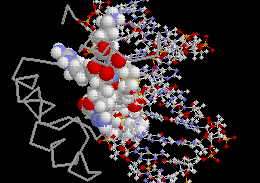

|
|
This page is not meant to be a comprehensive list of all the relevent interactions, but rather a demonstration of specific examples of some of the more important ones. For a more complete listing, see the references.

Again, the contacts made by helix III/IV are extensive. The major amino acids are show as spacefilled structures above on the grey protein backbone, and are in contact with the ball and stick DNA duplex. As you can see there are quite a few contacts spread throughout the region.
This picture demonstrates the contribution from glutamine 50. The two main bases that this amino acid contacts are the T and C (the sequence of the DNA in the structure is TCGGtAATCT - AGATTAcCGA where the lowercase bases are those contacted by Q50.) It is clear from the picture that hydrogen bond donors and acceptors are in range for specific interactions. This is a good example of how interactions in the major groove can provide for sequence specificity. If the carbonyl and amine groups in the DNA reversed positions these interactions would not only no longer aid in binding, but may sterically hinder it.
This picture demonstrates the contribution from isoleucine 47. The two main bases that this amino acid contacts are the T and A (the sequence of the DNA in the structure is TCGGtaATCT - AGATTACCGA where the lowercase bases are those contacted by I47.) These hydrophobic interactions aid in DNA binding.
Methionine 54 contacts C7 (the sequence of the DNA in the structure is TCGGTAATCT - AGATTAcCGA where the lowercase bases are those contacted by M54.) These interactions aid in DNA binding specificity. Met54 also contacts the phosphate backbone in a less specific manner.
Although they do not contribute greatly to the specificity of binding, the formation of salt bridges with the phosphate backbone in DNA is very important to the mechanism of binding. Contributing in this manner are the residues R43, R52, R53, and K55. Salt bridges are not the only interactions with the DNA backbone. Not pictured are hydrophobic interactions from R43, K46, I47, and M54.
Information in this project comes primarily from these references.

|
|
This page has been developed Donovan C. Haines as part of a VSNS-PPS course assignment. Email comments or problems to DCHaines@wsuhub.uc.twsu.edu.